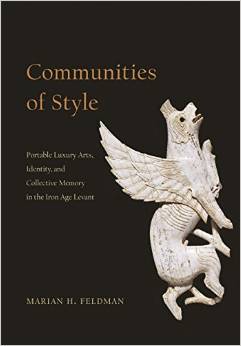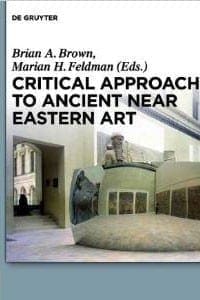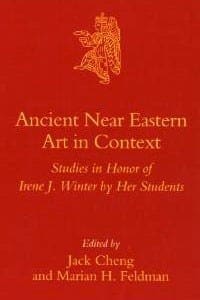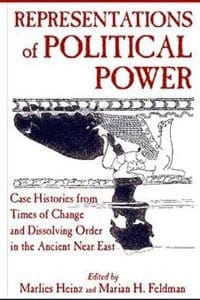
Marian Feldman
Professor, Diversity Champion; W.H. Collins Vickers Chair in Archaeology, & Director of Graduate Studies
Contact Information
- [email protected]
- Curriculum Vitae
- Gilman 174
- 410-516-2814
Research Interests: Ancient Near East and Eastern Mediterranean Art
Education: PhD, Harvard University
Marian Feldman holds a joint appointment in the Departments of the History of Art and Near Eastern Studies. She received her PhD in art history at Harvard University in ancient Near Eastern art and concentrates on the arts of the late third, second and first millennia BCE in the Near East and Eastern Mediterranean. Her interests range from questions regarding the role of the arts in cultural interactions and collective memory to issues of style, object agency, materiality and space.
Feldman’s first book, Diplomacy by Design: Luxury Arts and an ‘International Style’ in the Ancient Near East, 1400-1200 BCE (Chicago, 2006), investigates the role of artistic hybridity and luxury arts in international diplomacy during the Late Bronze Age. Her second book, Communities of Style: Portable Luxury Arts, Identity and Collective Memory in the Iron Age Levant (Chicago 2014), examines the ways communities form around -- and by means of -- art objects, focusing on portable luxury items (in particular, ivory and metalwork) in the first half of the first millennium BCE. Feldman has also co-edited several volumes, including Critical Approaches to Ancient Near Eastern Art (with Brian A. Brown; De Gruyter 2013), and is the author of several articles and catalogue essays. Her current book project investigates aspects of space, affect and agency in late third and early first millennium Mesopotamia.
Professor Feldman has held fellowships at the Institute for Archaeological Research (IAW) at the University of Freiburg (2019), the Internationales Kolleg Morphomata at the University of Cologne (2013), and the Center for Advanced Study in the Behavioral Sciences at Stanford University (2008-2009). She was recently a co-PI on the project “Material Entanglements in the Ancient Mediterranean and Beyond,” funded by the Getty Foundation “Connecting Art Histories” Initiative (2017-2020). She was a Getty Foundation “Connecting Art Histories” Visiting Professor at Bogaziçi University, Istanbul (March 2013) and a visiting professor at the University of Heidelberg (June 2010). She taught in the History of Art and Near Eastern Studies Departments at the University of California, Berkeley, before coming to Johns Hopkins in 2013.
Professor Feldman teaches classes in the arts and archaeology of the ancient Near East and eastern Mediterranean, including the arts of Mesopotamia, Assyria, Babylon, and the Levant. Her classes introduce students to these arts, while exploring broader historical, cultural, and disciplinary themes. Advanced undergraduate and graduate seminars investigate rotating topics in ancient Near Eastern art and archaeology with a particular focus on methodological and theoretical approaches. Questions related to the current political situation in the Middle East and the historiography of the discipline also are addressed.
Books
- Communities of Style: Portable Luxury Arts, Identity and Collective Memory in the Iron Age Levant. Chicago: University of Chicago Press, 2014.
- Diplomacy by Design: Luxury Arts and an ‘International Style’ in the Ancient Near East, 1400-1200 BCE. Chicago: University of Chicago Press, 2006.
- Critical Approaches to Ancient Near Eastern Art. Co-edited with B. Brown. Berlin: De Gruyter Press, 2013.
- Ancient Near Eastern Art in Context: Studies in Honor of Irene J. Winter by Her Students. Co-edited with J. Cheng. Leiden: Brill, 2007.
- Representations of Political Power: Case Histories from Times of Change and Dissolving Order in the Ancient Near East. Co-edited with M. Heinz. Winona Lake, IN: Eisenbrauns, 2007.
Articles
- “Levantine Art in the ‘Orientalizing’ Period.” In The Oxford Handbook of the Phoenician and Punic Mediterranean, ed. Brian Doak and Carolina López-Ruiz. Oxford: Oxford University Press, 2019. DOI: 10.1093/oxfordhb/9780190499341.013.24
- “Interaction with Neighboring Regions and Artistic Traditions: Ancient Near East and Bronze Age Aegean.” Pp. 565-584 in A Companion to the Art of the Ancient Near East, ed. Ann Gunter. Blackwell Companion to the Ancient World Series. Oxford: Wiley-Blackwell, 2018.
- “Style as a Fragment of the Ancient World: A View from the Iron Age Levant and Assyria.” Pp. 99-115 in The Tiny and the Fragmented: Miniature, Broken, or Otherwise “Incomplete” Objects in the Ancient World, ed. S. Rebecca Martin and Stephanie M. Langin-Hooper. Oxford: Oxford University Press, 2018.
- “Tracing Northern Networks among the Arts of Syria in the Middle and Late Bronze Ages.” Pp. 421-438 in Ebla and Beyond: Ancient Near Eastern Studies after Fifty Years of Discoveries at Tell Mardikh, Proceedings of the International Congress Held in Rome, 15th-17th December 2014, ed. Paolo Matthiae, Frances Pinnock and Marta D’Andrea. Wiesbaden: Harrassowitz, 2018.
- “Rethinking the Canon of Ancient Near Eastern Art in the Internet Age.” Journal of Ancient Near Eastern History 3/1 (2016): 57-79. DOI 10.1515/janeh-2016-0002.
- “Consuming the East: Near Eastern Luxury Goods in Orientalizing Contexts.” Pp. 227-233 in Assyria to Iberia: Art and Culture in the Iron Age, The Metropolitan Museum of Art Symposia, ed. Joan Aruz and Michael Seymour. New York: The Metropolitan Museum of Art, and New Haven and London: Yale University Press, 2016.
- “Houses of Ivory: The Consumption of Ivories in the Iron Age Levant.” Proceedings of a workshop on Levantine Ivories in the Iron Age held at the 61e Rencontre Assyriologique Internationale in Geneva and Bern, Switzerland, June 2015, ed. Claudia Suter, special issue of Altorientalische Forschungen 42/1 (2015): 97–111. DOI:10.1515/aofo-2015-0009.
- “In Pursuit of Luxury in Mesopotamia.” Pp. 121-126 in Joyful in Thebes: Egyptological Studies in Honor of Betsy M. Bryan, ed. Richard Jasnow and Kathlyn M. Cooney. Lockwood Press, 2015.
- “Qatna and Artistic Internationalism during the Late Bronze Age.” Pp. 33-41 in Qatna and the Networks of Bronze Age Globalism, Proceedings of an International Conference in Stuttgart and Tübingen in October 2009, ed. Peter Pfälzner and Michel Al-Maqdissi. Qatna Studien Supplementa 2. Wiesbaden: Harrassowitz, 2015.
- “Beyond Iconography: Meaning-Making in Late Bronze Age Eastern Mediterranean Visual and Material Culture.” Pp 337-351 in The Cambridge Prehistory of the Bronze and Iron Age Mediterranean, ed. A. Bernard Knapp and Peter van Dommelen. Cambridge: Cambridge University Press, 2014.
- “Religious, Communal, and Political Feasting in the Ancient Near East.” Pp. 63-68 in In Remembrance of Me: Feasting with the Dead in the Ancient Middle East, ed. Virginia R. Herrmann and J. David Schloen. Exhibition Catalogue. Oriental Institute Museum Publications 37. Chicago: The Oriental Institute of the University of Chicago, 2014.
- “The Art of Ivory Carving in the Second Millennium B.C.” Pp. 248-257 in Cultures in Contact: From Mesopotamia to the Mediterranean in the Second Millennium B.C., ed. Joan Aruz, Sarah B. Graff, and Yelena Rakic. The Metropolitan Museum of Art Symposia. New York: The Metropolitan Museum of Art; and New Haven and London: Yale University Press, 2013.
- “The Practical Logic of Style and Memory in Early First Millennium Levantine Ivories.” Pp. 198-212 in Materiality and Social Practice: Transformative Capacities of Intercultural Encounters, ed. Joseph Maran and Philipp W. Stockhammer. Oxford: Oxbow Books, 2012.
- “Assyrian Representations of Booty and Tribute as a Self-Portrayal of Empire.” Pp. 135-150 in Interpreting Exile: Displacement and Deportation in Biblical and Modern Contexts, ed. Brad E. Kelle, Frank Ritchel Ames, and Jacob L. Wright. Ancient Israel and Its Literature 10. Atlanta: Society of Biblical Literature, 2011.
- “Object Agency? Spatial Perspective, Social Relations, and the Stele of Hammurabi.” Pp. 148-165 in Agency and Identity in the Ancient Near East: New Paths Forward, ed. S. Steadman and J. Ross. London: Equinox, 2010.
- “Objects of Prestige? Chariots in the Late Bronze Age Eastern Mediterranean and Near East,” with Caroline Sauvage, Ägypten und Levante/ Egypt and the Levant 20 (2010): 67-181.
- “Hoarded Treasures: The Megiddo Ivories and the End of the Bronze Age,” Levant 41/2 (2009): 175-194.
- “Knowledge as Cultural Biography: Lives of Mesopotamian Monuments.” Pp. 40-55 in Dialogues in Art History, from Mesopotamia to Modern: Readings for a New Century, ed. Elizabeth Cropper. Studies in the History of Art Series 74, Center for Advanced Study in the Visual Arts, Symposium Papers LI, National Gallery of Art, Washington. New Haven and London: Yale University Press, 2009.

Communities of Style: Portable Luxury Arts, Identity, and Collective Memory in the Iron Age Levant
author
University of Chicago Press ,
2014

Critical Approaches to Ancient Near Eastern Art
co-author
Walter De Gruyter Inc ,
2014

Ancient Near Eastern Art in Context: Studies in Honor of Irene J. Winter by Her Students
co-editor
BRILL ,
2007

Diplomacy by Design: Luxury Arts and an “International Style” in the Ancient Near East, 1400-1200 BCE
author
University Of Chicago Press ,
2006
